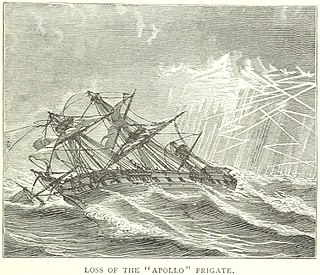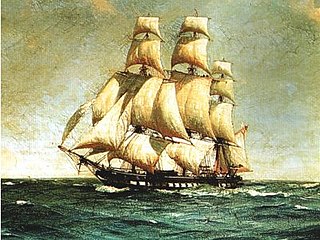
HMS Apollo, the fourth ship of the Royal Navy to be named for the Greek god Apollo, was a fifth-rate frigate of a nominal 36 guns. She was the name ship of the Apollo-class frigates. Apollo was launched in 1799, and wrecked with heavy loss of life in 1804.
HMS Fly was a Swan-class ship sloop of the Royal Navy, launched on 14 September 1776. She performed mainly convoy escort duties during the French Revolutionary Wars, though she did capture three privateers. She foundered and was lost with all hands early in 1802.
Vénus was a corvette of the French Navy that the British captured in 1800. Renamed HMS Scout, she served briefly in the Channel before being wrecked in 1801, a few days after taking a major prize.

Sensible was a 32-gun Magicienne-class frigate of the French Navy. The Royal Navy captured her in 1798 off Malta and took into service as HMS Sensible. She was lost in a grounding off Ceylon in 1802.

HMS Leveret was a Cruizer-class brig-sloop built at Dover, England, and launched in 1806. She was wrecked in 1807.
During the French Revolutionary and Napoleonic Wars the Admiralty also made use of hired armed vessels, one of which was His Majesty's Hired armed cutter Swan. Actually there were two such cutters, but the descriptions of these vessels and the dates of their service are such that they may well represent one vessel under successive contracts. The vessel or vessels cruised, blockaded, carried despatches and performed reconnaissance.
During the French Revolutionary and Napoleonic Wars the Royal Navy used several vessels that bore the designation His Majesty's hired armed cutter Lord Nelson, all named for Lord Horatio Nelson.

L'Espoir was a French brig-sloop that served for 9½ years in the French Navy before HMS Thalia captured her in September 1797. In her subsequent short career in British service as HMS Espoir she captured three prizes, with the capture in 1798 of the more heavily armed Genoese pirate Liguria earning her crew a clasp to the Naval General Service Medal. Espoir was laid up in 1799 and sold in 1804.
His Majesty's Hired armed cutter Lurcher was a 12-gun cutter that served the Royal Navy from 15 August 1795 until 15 January 1801 when a French privateer captured her in the Channel.

Gracieuse was a 32-gun Charmante-class frigate of the French Navy. Renamed to Unité in 1793, she took part in the French Revolutionary Wars. The Royal Navy captured her in 1796 off Île d'Yeu and brought her into British service as HMS Unite. She was sold in 1802

HMS Proserpine was a 28-gun Enterprise-class sixth-rate frigate of the Royal Navy. She was launched in 1777 was wrecked in February 1799.
HMS Garland was the French privateer Mars, launched in 1798 that Amethyst captured in 1800. The Royal Navy took her into service and sent her out to the Jamaica Station. There she had a brief, eventful career before she was wrecked in 1803.
HMS Port Royal was a 10-gun schooner that the British Royal Navy bought in Jamaica in 1796. The French captured her in 1797 and the British recaptured her later that year, when they renamed her HMS Recovery. She captured three privateers, one in a single-ship action, before the Navy sold her in 1801.

Etna was a French naval Etna-class ship-sloop launched in 1795 that the Royal Navy captured in November 1796. She was taken into service as HMS Aetna and renamed to HMS Cormorant the next year. She captured several merchant vessels and privateers before she was wrecked in 1800 off the coast of Egypt.
Premier Consul was a French privateer launched in 1800 at Nantes. The Royal Navy captured her in 1801 and renamed her HMS Scout. She foundered later that year with the loss of her entire crew.
HMS Deux Amis was the French privateer schooner Deux Amis, launched in 1796. The British captured her in December 1796 and the Royal Navy took her into service under her existing name. She made one capture before wrecking in May 1799.

The French schooner Impériale was a 3-gun mercantile schooner-aviso of the French Navy commissioned at Guadeloupe on 23 September 1805. The Royal Navy captured her on 24 May 1806 and named her HMS Vigilant. The Navy renamed her HMS Subtle on 20 November 1806. She wrecked at Bermuda on 20 October 1807.

HMS Barbuda was commissioned into the Royal Navy in 1780 after having briefly served as an American privateer. Barbuda was one of the two sloops that captured Demerara and Essequibo in 1781, but the French Navy captured her there in 1782 and took her into service as Barboude. The French Navy sold her to private owners in 1786, and she served briefly as a privateer in early 1793 before the French Navy purchased her again and named her Légère. She served them until mid-1796 when the Royal Navy captured her and took her into service as HMS Legere. She was wrecked off the coast of Colombia, without loss of life, in February 1801.

HMS Bonetta was the French privateer Huit Amis, launched at Bordeaux in 1798 that the British Royal Navy captured in May. In her brief naval career she captured a number of small prizes, one of them a 2-gun privateer. Bonetta was wrecked in 1801.
HMS Requin was the French Navy cutter Requin, launched at Boulogne in 1794. HMS Thalia captured Requin in 1795. Requin captured one small French privateer and participated in the capture of Suriname before wrecking in 1801.









